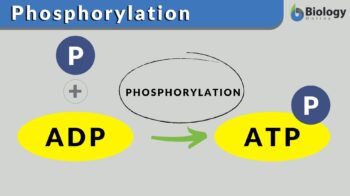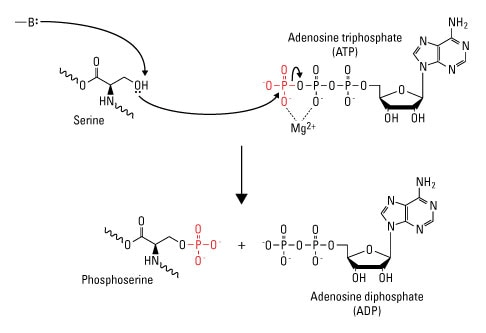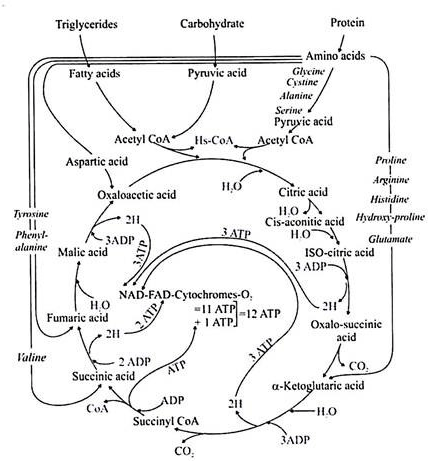
Phosphorylation
n.
[ˌfɒsfərɪˈleɪʃən]
Definition: The transferring of a phosphoryl group to a molecule
Table of Contents
Phosphorylation Definition
We can define phosphorylation as a biochemical process in which a phosphate molecule is added to some organic compound, such as glucose and adenosine diphosphate (ADP). In the latter example, the addition of phosphate group converts ADP to adenosine triphosphate (ATP), which is a very important compound that is used to provide energy to carry out several processes in living cells such as nerve impulse propagation and muscle contraction.
a. What is phosphorylation?
The simple answer is that it is the addition of a phosphate molecule to some organic compound.
b. What does phosphorylation mean?
Phosphorylation can be considered as one of the vital biochemical reactions in which phosphate molecules are added to some organic compound to make it usable for several functions in a living being. Another related word is “phosphorylate”, which also means the introduction of a phosphoryl group into an organic compound.
c. Phosphorylation reaction in biology
Phosphorylation reaction is of particular importance in biology because several biological processes depend upon this reaction such as apoptosis, inflammation, regulation of metabolism, subcellular trafficking, and proliferation. In biology, phosphorylation is the transfer of phosphate molecules to a protein. This transfer prepares the proteins for specialized tasks in a living being.
d. Where does phosphorylation occur?
The phosphorylation in mammals occurs at side chains of three amino acids: (1) tyrosine (an amino acid produced in the body of living organisms from another amino acid, “phenylalanine”), (2) serine, and (3) threonine. However, some studies have also found that histidine phosphorylation is also present.
e. Which amino acids can be phosphorylated?
The amino acids that can be phosphorylated are tyrosine, serine, and threonine.
f. Which type of enzyme adds a phosphate group to another molecule?
Phosphorylation is a reversible reaction; it means that a phosphate molecule can be added and removed. The enzymes that are responsible for adding phosphate groups to proteins are known as “kinases”. Those involved in the removal of these phosphate groups are called “phosphatases”.
Purposes of Phosphorylation
The question here arises is what is the purpose of phosphorylation? Phosphorylation is involved in many vital biological processes. It is involved in the regulation of protein functions and signal transmission in the cells. It is also involved in cell growth, signal transduction, cell development, protein synthesis, and cell division.
Phosphorylation is a reversible reaction. Most of the enzymes and receptors are activated and deactivated by phosphorylation and dephosphorylation (opposite of phosphorylation process), respectively. The phosphorylation of enzymes serves as a type of on/off switch, thus altering the specific activity or function.
The phosphate molecule itself is a very important element of biomolecules. The researchers have found that a large number of metabolites (an intermediate or end product of metabolism) undergo phosphorylation resulting in the formation of corresponding phosphates in cells.
Initially, two scientists Thomas Rall and Earl Sutherland were working on research targeted at the relationship between glucagon and epinephrine with the enzyme, glycogen phosphorylase present in the liver. They found that the aforementioned hormones were involved in the production of 3,5-cyclic adenosine monophosphate. This chemical was found to work inside a cell to implement changes in phosphorylase activity. Thus 3,5-cyclic adenosine monophosphate is a chemical that is used as a messenger of specific hormonal signals.
Protein activities are controlled by the phosphorylation of tyrosine. Tyrosine is an amino acid produced by our body from another amino acid known as phenylalanine. The phosphorylation of controlling tyrosine induces changes in the substrate that are involved in enzymatic activity. Some other purposes of phosphorylation include (Ardito et al., 2017):
- Protein degradation
- Regulation of enzyme inhibition
- Function in glycolysis
- Signaling between proteins
- Regulates the energy-requiring chemical reactions.
- Phosphorylation Mechanism
Protein phosphorylation occurs on the side-chain of three distinct amino acids, namely serine, threonine, and tyrosine, which are reversibly phosphorylated in eukaryotic cells.
What happens to a molecule when it is phosphorylated? What does phosphorylation do to a molecule?
In these amino acids, the nucleophilic (–OH) group is targeted at the terminal phosphate group. The nucleophilic (–OH) group in these amino acids targets the phosphate terminal group (γ-PO32-) and is moved to the amino acid side chain from the phosphate group by the standard phosphoryl donor adenosine triphosphate (ATP), also known as ATP phosphorylation. Magnesium (Mg2+) promotes this transition, which lowers the threshold of phosphoryl transmission through the nucleophilic (–OH) group in the γ- and ß-phosphate groups. This phosphorylation reaction is in one direction due to the vast quantity of free energy produced when ATP is disturbed to generate adenosine diphosphate (ADP) in phosphate -phosphate linkage (Silversmith, Appleby, Bourret, 1997).

Why are proteins phosphorylated and what roles can phosphorylation play in protein function?
Phosphorylation is closely linked to protein activity and is a crucial point in regulating protein function across a wide variety of proteins. Phosphorylation governs protein function and cell signaling by inducing conformational alterations in the phosphorylated protein. All these modifications by phosphorylating a protein have an effect on the protein in two ways. Firstly, the catalytic activity of the protein is monitored by conformational alterations. Hence, phosphorylation can activate or disable a protein.
Secondly, phosphorylated proteins are recruiting surrounding proteins that have structurally retained domains, which identify and link with phosphomotifs. These domains are distinguished by unique amino acids. For instance, the Src homology2 (SH2) domain, and phosphotyrosine-binding (PTB) domain demonstrate phosphotyrosine (pY) specificity, though differences between these two types are specific to the different phosphotyrosine species.
Recognition domains for phosphoserine (pS) comprise both the MH2 domain as well as the WW domain while phosphothreonine (phosphorylated threonine) (pT) is identified by forkhead-associated FHA domains.
For signal transduction, the capacity of phosphoproteins to recruit other proteins, in which phosphorylated signal protein, is recruited downstream.
The reversible post-translational modifications (PTM) is considered to be protein phosphorylation, which is regulated by kinases to phosphorylate and phosphatases to dephosphorylate substrates. Both two enzyme classes promote the phosphorylated protein dynamics behavior in a cell. In fact, in a single cell, the magnitude of the phosphoproteome would depend on the spatial and temporal equilibrium between the concentrations of kinase and phosphatase within the cell and the catalytic performance at a particular position.

Protein kinases
Kinases are enzymes that promote the transition of phosphate to substrates. The human proteome has predicted more than 500 kinases. The human kinome contains this subset of proteins. Kinase activity substrates are complex and consist of lipids, sugars, nucleotides, and proteins.
While guanosine triphosphate is used in a few kinases, ATP is the co-substrate almost for every protein kinase. For nucleotidyl-, pyrophosphoryl- and phosphoryl conversion, ATP is perfect for the transition of α-, β– or γ-phosphate classes, respectively. The ATP binding site is usually retained whereas the substrate specificity of kinases differs.
Protein kinases are classified into subgroups that have specificity and contain tyrosine kinases or serine/threonine kinases for unique catalytic domains. Serine/threonine kinases constitute roughly 80 percent of the mammalian kinome, and pS and pT are composed of more than 90 percent of the phosphoproteome. Research has indicated that 1800:200:1 is the relative abundance ratio of pS:pT:pY in a cell. While pY may not be as widespread as pS and pT, owing to its connection to human illness through the dysregulation of receptor tyrosine kinases (RTKs), global tyrosine phosphorylation is at the top of the priority list of biomedical science (Taylor & Kornev, 2011).
The specificity of the protein kinase substrate is dependent not only on the desired amino acid but also on the consensual sequences that surround it. These consensual sequences permit the phosphorylation of a single protein in certain kinases and several phosphorylated substrates (>300). Consequently, Kinases may also be able to phosphorylate individual protein single or many amino acids where kinase-specific consensus sequences are accessible.
The kinases have control sub-units that serve as activating or auto-inhibiting domains with different regulatory substrates. A typical approach to controlling kinase activity is the phosphorylation of these subunits. In the basal state, most protein kinases are dephosphorylated and inactive. A limited number of phosphorylated kinases are constitutively active and inherently inefficient or inactive. In certain kinases, including Src, phosphorylation, and dephosphorylation have to be mixed, showing that this proto-oncogene is highly regulated. The kinase behavior can also be regulated by scaffolding and adaptor proteins by controlling the spatial interaction among kinases and upstream and downstream regulators.
Incubating immunoprecipitate with substrates of various kinases and ATP will test the activity of particular kinases. For this form of the assay, commercial tools are available and are equipped to achieve colorimetric, radiometric, or fluorometric identification. Although this form of assays displays the activity, including kinase enrichment, of particular kinases, they do not include details on the proteins that kinases change or the action of endogenous phosphatase activity.
Signal transduction cascades
How is phosphorylation important in a signal transduction cascade?
This form of PTM is suitable to signal transduction because of the reversibility of protein phosphorylation, meaning that cells can easily adapt to intracellular or extracellular stimuli. Signal transduction cascades of the signal are distinguished by one or more proteins that sensitively signify the physical sensors by either the binding of a ligand or cleavage or some other reaction. These receptors activate downstream in the event of kinases phosphorylation, and then phosphorylate and activate their cognate downstream substrates, along with further kinases, before the precise response is reached. Signal transduction cascades may be linear, where kinase A activates B and subsequently kinase C, and so on. Signaling pathways that enhance the initial signal were also identified; kinases A activate several kinases, which ultimately stimulate extra kinases. A single molecule can cause global cellular activities like proliferation, for example, with this kind of signal.

Protein phosphatases
There are three pathways regulating the rate and extent of phosphorylation-related signaling:
- Separation of the stimulating ligand
- Proteolysis of kinase or substrate
- Dephosphorylation of Phosphatase
It is known that the human proteome includes around phosphatases of 150 proteins that are of pS pT and pY residue specimen. Although the end target of both phosphatase groups is dephosphorylation, they are doing so by means of different pathways. The immediate hydrolysis in the phosphorus group of the phosphorus atom is regulated by serine/threonine phosphatases by bimetallic centers, (Fe/Zn) and tyrosine. Phosphatases develop a thiophosphoryl covalent intermediate that allows the elimination of tyrosine residues.
Types of Phosphorylation
Several kinds of molecules can be subject to phosphorylation and dephosphorylation. Three of the most common forms of phosphorylation are:
- Glucose phosphorylation
- Protein phosphorylation
- Oxidative phosphorylation
Glucose phosphorylation
Phosphorylation of glucose takes place when initially glucose is phosphorylated with various other sugars in its catabolism. In glycolysis, for instance, D-glucose is initially converted into D-glucose-6-phosphate. Glucose is a rapidly permeated small molecule. The tiny nature of glucose tends to penetrate quickly in the cells.
Phosphorylation is a bigger enzyme that cannot quickly penetrate the tissue. Phosphorylation is also essential to the regulation of blood glucose concentrations. The concentration of glucose, in particular, is directly linked to the production of glycogen. Glucose phosphorylation is also associated with cardiac development.
Protein phosphorylation
Protein phosphorylation takes place as the amino acid is attached to the phosphorylate group. Typically the amino acid is serine even though threonine and tyrosine are in eukaryotes and histidine in prokaryotes is still found with phosphorylation. This is considered an esterification reaction when one phosphate group interacts with the hydroxyl (-OH) group of a serine, threonine, or tyrosine side chain. The amino acid is covalently attached with the phosphate group through the enzyme protein kinase. The exact mechanism varies considerably among prokaryotes and eukaryotes. Post-translational modifications (PTM), indicating that the proteins are phosphorylated following conversion from RNA pattern, seem to be the best-studied type of phosphorylation. Protein phosphatases catalyzed the dephosphorylation and reverse reactions.
DNA phosphorylation
The phosphorylation of histones can be regarded as an important example of protein phosphorylation. DNA is paired with chromatin-forming histone proteins in eukaryotes. Histone phosphorylation affects the chromatin structure and changes the relationships between the DNA-protein and protein-protein. Typically, phosphorylation takes place when DNA is destroyed, providing new places across damaged DNA just so the repair techniques can function properly.
Protein Phosphorylation plays a crucial role in the metabolism and signaling pathways, in addition to its significance in DNA repair.
Oxidative phosphorylation
The chemical energy released and absorbed by a cell is carried out through oxidative phosphorylation. Reactions within the mitochondria arise in the eukaryotic cell. Oxidative phosphorylation contains interactions in the electron transport chain and chemiosmosis. In conclusion, the transmission of electrons by redox reaction from molecules and proteins through electron transport chain into the inner membrane of mitochondria, producing the energy required to create adenosine triphosphate (ATP) in chemiosmosis.
During this process, NADH and FADH2 transmit electrons to the transport chain of electrons. Electrons flow from higher to lower energy as they move down the chain and release energy along the way. To develop an electrochemical gradient, much of this energy goes to moving hydrogen ions (H+). At the end of the network, electrons are converted to oxygen, creating water by interacting with H+ ions. These ions deliver ATP synthase energy to the ATP synthesizer. Degrading the phosphate group produces energy in a way that can be consumed by the cell as ATP is dephosphorylated.
Adenosine may not be the only base undergoing phosphorylation to produce AMP, ADP, and ATP. Guanosine, for example, may also develop GMP, GDP, and GTP.
Detecting Phosphorylation
The mass spectrometer, electrophoresis, and antibodies are used to detect the phosphorylation of a molecule. However, it is hard to recognize and characterize phosphorylation sites. Isotope marking is also used in combination with fluorescence, electrophoresis, and immunoassays.
Biological Importance of Phosphorylation
In the transaction energy of living organisms, some organic phosphates, which develop tissues by anabolic chemical reactions, play a major role. In the analysis of Harden and Young, which showed that the fermentation of glucose by cell-free yeast juice quickly improved when inorganic phosphorus was applied to the media, and subsequently transformed to organic phosphate, the importance of organic phosphates in metabolism was shown and the findings were reported.
Physiological Importance of Phosphorylation
The cell protoplasm is constructed from phosphoric acid. For all cells, therefore, phosphorylation is an important chemical process. It also plays a vital function when absorbing and metabolizing multiple food products.
Its influence on the multiple metabolism pathways is described below:
In Relation to Carbohydrates:
i. Phosphorylation is beneficial for the absorption of carbohydrates by the intestinal mucosa as well as for the reabsorption of renal glucose. In each of these epithelial, hexose phosphate is created. This molecule adopts dephosphorylation, hexoses reach the bloodstream, and phosphoric acid is left alone.
ii. Glycogen synthesis from glucose and glycogen degradation into glucose in the liver and muscles is thought to occur during phosphorylation.
iii. Phosphorylation usually occurs throughout all stages during chemical changes following muscle contraction. Phosphorylation and dephosphorylation alternately take place here. A variety of phosphorylated compounds break down glycogen into lactic acid.
In relation to Fats:
i. Neutral fats and phospholipids are produced in the absorbing epithelium mostly during the digestion of fats. Phosphorylation is formed by the enzyme phosphorylase.
ii. Phospholipids, especially lecithin, are the synthesis of the liver. The transportation of fat is a very necessary step. It also serves as the main stage when fatty acids are more oxidized. Oxidation of fatty acid is a mitochondrial function.

In Relation to Proteins and Vitamins:
The production of all phosphoproteins, including nucleoproteins, caseinogens, etc is an essential step.
Phosphorylation is therefore likely to play an important function in the oxidation of tissue through which proteins, fats, and carbohydrates are ultimately decomposed.
As far as the vitamin is concerned. Some vitamin B groups contain compounds such as riboflavin phosphate, thiamine pyrophosphate, etc. In the oxidation and reduction stages in the cells, they are assumed to be coenzymes.
Control of Phosphorylation
The phosphorylation is thought to be specifically due to the adrenal cortex. The inhibition of phosphorylation adrenalectomy is accelerated by the glucocorticoids.
The anterior pituitary may provide an advanced phosphorylation regulation by the adrenal cortex through its adrenocorticotropic hormone. A subsequent phosphorylation disruption, which affects absorption, metabolism, and body nutrition, may partially explain the marasmic state of adrenal cortex diseases
Try to answer the quiz below to check what you have learned so far about phosphorylation.
References
1. Ardito, F., Giuliani, M., Perrone, D., Troiano, G., & Lo Muzio, L. (2017). The crucial role of protein phosphorylation in cell signaling and its use as targeted therapy. International Journal of molecular medicine, 40(2), 271-280.
2. Taylor, S. S., & Kornev, A. P. (2011). Protein kinases: evolution of dynamic regulatory proteins. Trends in biochemical sciences, 36(2), 65-77.
3. Silversmith, R. E., Appleby, J. L., & Bourret, R. B. (1997). Catalytic mechanism of phosphorylation and dephosphorylation of CheY: kinetic characterization of imidazole phosphates as phosphodonors and the role of acid catalysis. Biochemistry, 36(48), 14965-14974.
4. Retrieved from https://www.biologydiscussion.com/metabolism/phosphorylation/phosphorylation-importance-and-control-metabolism-cells-biology/81968.
5. Retrieved from https://www.thermofisher.com/pk/en/home/life-science/protein-biology/protein-biology-learning-center/protein-biology-resource-library/pierce-protein-methods/phosphorylation.html#.
©BiologyOnline.com. Content provided and moderated by BiologyOnline Editors.





